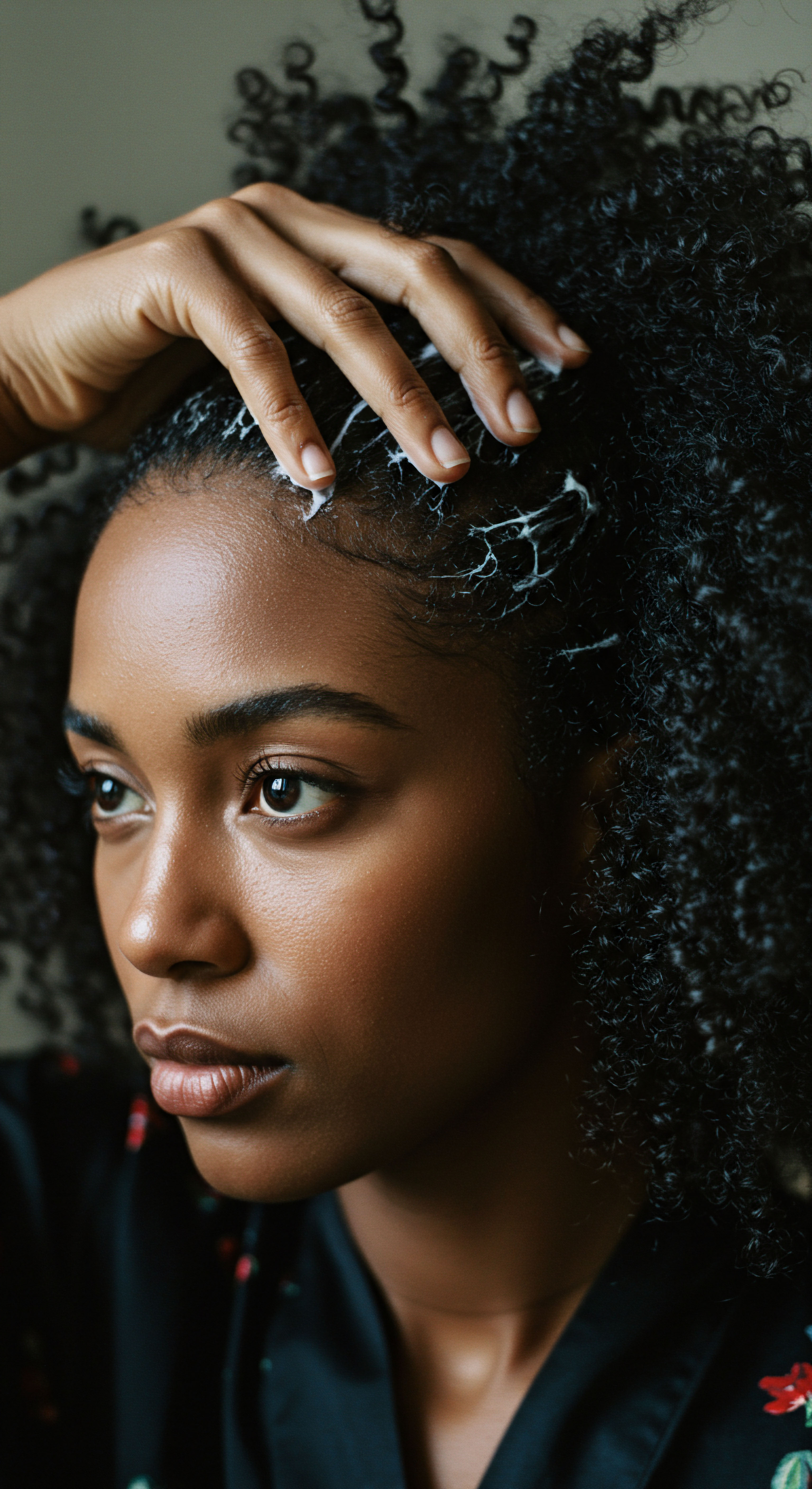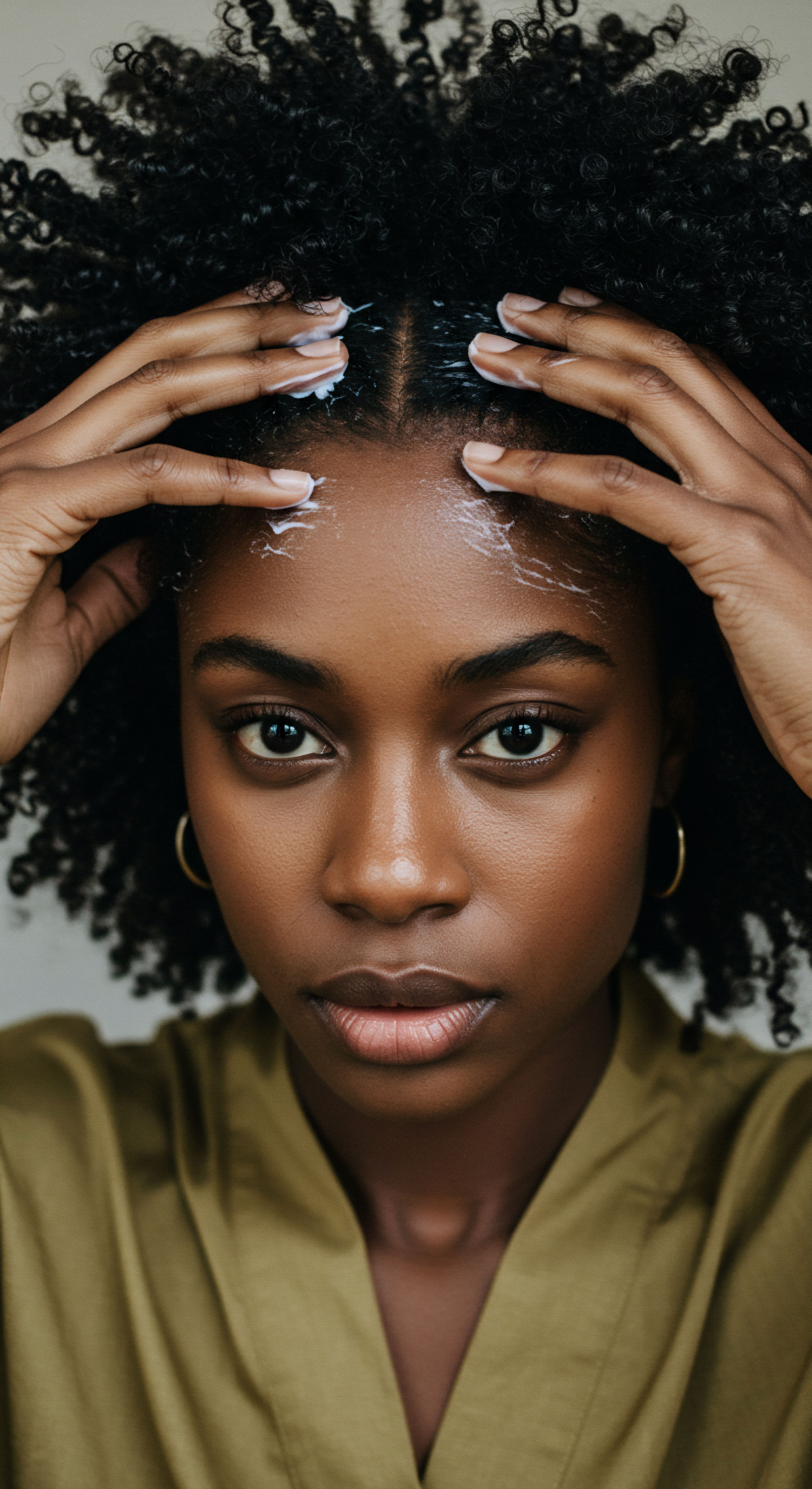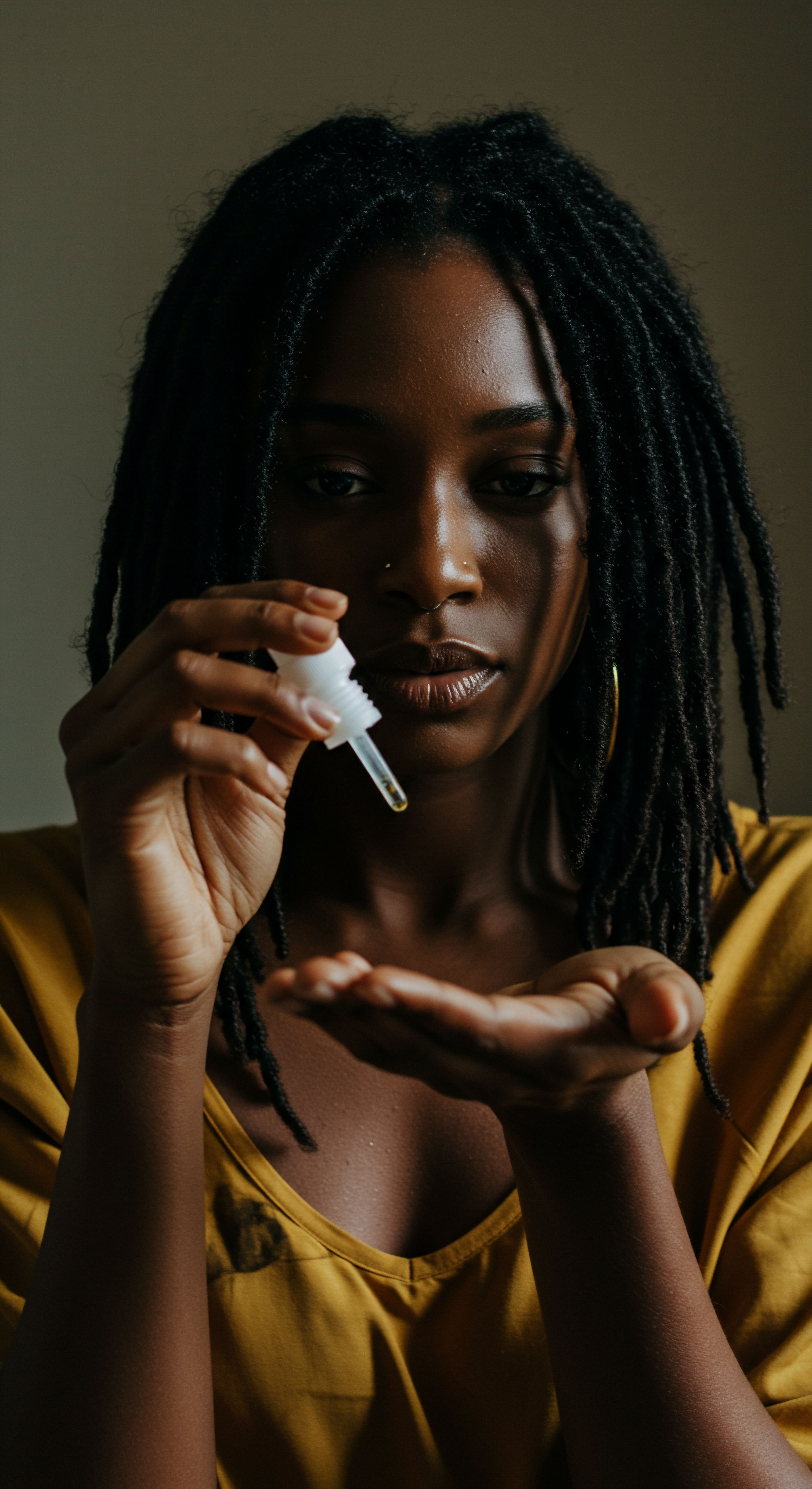The air hangs heavy, a silent, damp embrace that can leave skin feeling stifled and hair rebellious. For those with a sensitive scalp, this atmospheric shift often brings an unwelcome symphony of discomfort—itching, redness, and a feeling of imbalance. Our quest to find serenity amidst the humidity leads us back to nature’s quiet wisdom, to ingredients that have long offered solace and balance. The answer, as it so often is, lies in a blend of ancient knowledge and modern scientific understanding, revealing how specific botanical allies can restore calm when the air feels thick with moisture.

Roots
The very ground beneath our feet, the origin point of all growing things, offers a profound understanding of how our bodies respond to the elements. Just as a plant draws sustenance from the earth, our scalp, a living ecosystem, reacts to its surroundings. When humidity climbs, the scalp’s delicate balance can waver.
The warmth and moisture create an inviting environment for certain microorganisms, like the yeast-like fungus Malassezia, which naturally resides on our scalp but can proliferate excessively under these conditions, leading to irritation and flaking. This microscopic world, often overlooked, holds a key to understanding why our scalp might protest the summer air.

Understanding Scalp Responses to Humidity
Our scalp, a unique skin surface, operates within its own microclimate. It boasts a high volume of sebum production and, particularly in textured hair, can experience an unusually humid environment due to hair density and curl patterns. This creates a distinctive habitat for various microorganisms. When external humidity increases, this internal microclimate can become even more pronounced, impacting the scalp’s pH balance and the equilibrium of its microbial inhabitants.
A healthy scalp microbiome acts as a shield against harmful pathogens and helps regulate pH, playing a significant role in managing inflammation. Disruptions, therefore, can lead to increased sensitivity, redness, and a feeling of unease.
The challenge of a sensitive scalp in humid weather is not merely about managing visible symptoms; it extends to supporting the scalp’s intrinsic functions. When the scalp is well-cleansed and cared for, it provides a healthy environment for optimal hair growth and helps avert problems like hair breakage or other scalp issues. This foundational care, deeply connected to the scalp’s physiological needs, forms the bedrock of any effective regimen.

The Wisdom of Traditional Botanical Use
Across diverse cultures, particularly those in humid climates, ancestral knowledge has long pointed to specific plants for their calming and balancing properties. These traditions, passed through generations, often hold empirical truths that modern science now seeks to validate. For instance, the use of plants with anti-inflammatory and antimicrobial properties has been a recurring theme in traditional hair care for centuries. This shared wisdom speaks to a deep connection between humanity and the botanical world, recognizing plants not just for their aesthetic beauty but for their profound healing capabilities.
The scalp’s internal microclimate, influenced by external humidity, requires thoughtful care to maintain its natural balance.
The historical use of natural ingredients in hair care is well-documented, with various plant elements providing essential nutrients for scalp and hair health. These ingredients, often minimally processed, retain their original properties, offering a gentler approach to care compared to many synthetic alternatives. This historical context provides a rich backdrop for our contemporary understanding, allowing us to appreciate the enduring efficacy of these natural remedies.

Ritual
Stepping into the realm of daily care, we seek practical wisdom that resonates with the rhythms of our lives. The pursuit of a calm scalp in humid weather becomes a conscious practice, a ritual born of understanding and gentle application. This is where the foundational knowledge of the scalp’s needs meets the tangible actions we can take, transforming routine into a purposeful act of nurturing. It is a dialogue between our body and the earth’s offerings, a quiet commitment to well-being that sidesteps superficial solutions.

Selecting Calming Natural Ingredients
When humidity rises, the sensitive scalp often reacts with increased oiliness, itchiness, and sometimes, the proliferation of microorganisms. Certain natural ingredients possess properties that can soothe irritation, balance sebum production, and support a healthy scalp microbiome.
- Aloe Vera ❉ This succulent plant is widely recognized for its moisturizing and soothing properties. It contains polysaccharides and glycoproteins that promote skin hydration and can reduce inflammation, offering relief from itching. An older study comparing aloe vera gel with a placebo in participants with seborrheic dermatitis, a condition causing scaly, flaky skin, found aloe vera gel more effective in reducing scaliness and itching. Its application can provide immediate relief and aid in maintaining overall scalp health.
- Chamomile Extract ❉ Derived from the chamomile flower, this extract is known for its anti-inflammatory and soothing attributes. It can calm irritated skin, reduce redness, and potentially assist in managing conditions like dandruff. Components like apigenin within chamomile are particularly noted for their anti-inflammatory effects, which can help soothe scalp irritation and support a balanced pH.
- Tea Tree Oil ❉ This essential oil possesses strong antimicrobial, antifungal, and anti-inflammatory properties, making it a powerful ally against scalp issues often exacerbated by humidity, such as dandruff. When diluted and applied, it can offer relief from itchiness and irritation.
- Witch Hazel ❉ As an astringent, witch hazel can help with symptoms of a dry scalp, including itchiness, and has protective anti-inflammatory properties. It can cleanse the scalp and may be misted on after rinsing conditioner or mixed with carrier oils for a pre-shampoo treatment.
- Neem Oil ❉ With its anti-inflammatory and antimicrobial properties, neem oil can be effective in addressing scalp conditions like dandruff and psoriasis, providing relief from irritation. Though research on neem oil specifically for scalp conditions is still developing, some older studies indicate its potential in alleviating skin inflammation.

Crafting a Gentle Scalp Care Practice
A consistent and gentle scalp care practice is paramount, especially when dealing with sensitivity in humid conditions. The aim is to cleanse effectively without stripping the scalp’s natural oils, which can trigger further irritation or excessive oil production.
Consider a weekly regimen that includes a gentle pre-shampoo treatment. A blend of a soothing oil, such as jojoba or almond oil, with a few drops of a calming essential oil like tea tree or lavender, can be massaged into the scalp. Jojoba Oil, similar to the scalp’s natural oils, moisturizes without heaviness, while Almond Oil provides deep hydration. This can be left on for a period before a mild shampoo, allowing the botanical properties to settle and prepare the scalp for cleansing.
| Ingredient Aloe Vera |
| Primary Benefit Soothing, hydrating, anti-inflammatory |
| Application Note Direct gel application or in formulations |
| Ingredient Chamomile Extract |
| Primary Benefit Anti-inflammatory, calming, redness reduction |
| Application Note As an extract in rinses or products |
| Ingredient Tea Tree Oil |
| Primary Benefit Antimicrobial, antifungal, anti-inflammatory |
| Application Note Diluted with carrier oil, used in shampoos |
| Ingredient Witch Hazel |
| Primary Benefit Astringent, anti-inflammatory, cleansing |
| Application Note Misted, or mixed with carrier oils |
| Ingredient Neem Oil |
| Primary Benefit Antimicrobial, anti-inflammatory |
| Application Note Massaged into scalp, can be left on |
When selecting shampoos and conditioners, prioritize those free from harsh sulfates, parabens, and synthetic fragrances, as these can disrupt the scalp’s delicate ecosystem and exacerbate sensitivity. Look for products with balanced pH levels and botanical extracts that gently purify while preserving the scalp’s protective barrier.
A consistent, gentle regimen with selected botanicals helps the scalp adapt to humid conditions.
Rinsing thoroughly is also critical to prevent product residue buildup, which can contribute to irritation and flaking. After cleansing, a final rinse with cooled herbal tea, such as chamomile or green tea, can further soothe the scalp and add shine to hair. This ritualistic approach respects the scalp’s needs, offering a holistic pathway to comfort in humid climates.

Relay
Our understanding deepens as we move beyond immediate remedies to the intricate interplay of factors that influence scalp well-being in humid conditions. This exploration demands a thoughtful gaze, one that considers not only the biological responses but also the broader environmental and even societal currents that shape our hair care practices. It is here that the scientific rigor meets the lived experience, offering a profound perspective on how we can truly support a sensitive scalp.

How Does the Scalp Microbiome Respond to Humidity?
The scalp is home to a complex ecosystem of bacteria, fungi, and other microorganisms, collectively known as the scalp microbiome. This invisible community plays a significant role in maintaining scalp health, protecting against pathogens, regulating pH, and controlling inflammation. Humidity, along with factors like sebum production and hair density, creates a specific microenvironment on the scalp that influences the composition of this microbiome.
In highly humid environments, there is a tendency for certain fungal species, particularly Malassezia, to overgrow. This overgrowth is a common contributor to dandruff and seborrheic dermatitis, conditions characterized by flaking, itching, and inflammation. The Malassezia fungus feeds on the oils produced by the scalp, and increased sweat and sebum production in hot, humid weather can provide an abundant food source, accelerating its multiplication. This delicate balance underscores why managing humidity’s impact on the scalp is not merely about comfort but about preserving a healthy microbial landscape.
Interestingly, research suggests that the use of natural products may help maintain a more balanced microbiome, contrasting with some antimicrobial or antifungal products that, while treating infections, can reduce microbial diversity. This points to a nuanced approach where gentle, natural interventions might support the scalp’s inherent defenses rather than disrupt them.

Are Certain Essential Oils Too Potent for Sensitive Scalps in Humidity?
While many essential oils offer therapeutic properties, their potency can be a double-edged sword, especially for sensitive scalps in humid conditions. The Mielle Organics controversy, where some users reported hair loss and severe damage, highlighted concerns about certain essential oils like rosemary and peppermint. Cosmetic chemist Ginger King noted that irritants like peppermint and nicotinate could cause irritation, and if individuals with sensitive scalps scratch due to the intended sensations, it could contribute to hair loss.
The debate around essential oils in hair care reveals a spectrum of sensitivities.
This situation brings to light the importance of individual sensitivity and proper dilution. While some studies suggest benefits for ingredients like rosemary oil in promoting hair growth, a 2015 clinical study on its efficacy was conducted solely on 50 men, without including women, raising questions about its universal applicability and potential for irritation in a broader population. This underscores the need for careful consideration and patch testing, particularly for those with a history of scalp sensitivity or inflammatory conditions like eczema or psoriasis.

The Role of Hydration and Antioxidants Beyond Topical Application
Maintaining a calm scalp in humid weather extends beyond what we apply directly. Systemic hydration and a diet rich in antioxidants play a significant supporting role. Dehydration can leave the skin, including the scalp, more prone to dryness and itchiness, even in humid conditions where one might assume sufficient moisture. Ensuring adequate water intake helps to moisturize the skin from within.
Furthermore, botanical extracts known for their antioxidant and anti-inflammatory properties can be beneficial not only topically but also through dietary consumption. Research has explored the potential of botanical-based oral ingredients in counteracting the negative impacts of environmental stress on the skin. Ingredients like blueberry, green tea, grape, pomegranate, and various marine algae are recognized for their antioxidant, anti-inflammatory, and skin-protective attributes, offering a promising approach to enhancing skin resilience.
Consider a study on a topical treatment containing probiotic extracts, honey, turmeric, and vitamin B12, designed to restore a healthy skin microbiome and reduce dry scalp symptoms. This intervention, tested in children, showed a reduction in itchiness, dryness, irritation, and flakiness. While further research is needed to solidify the link between microbiome balance and observed improvements, this case points to the multifaceted benefits of ingredients that support internal and external well-being.
| Factor Malassezia Overgrowth |
| Impact on Scalp Microbiome Can lead to dandruff and irritation |
| Relevance to Humidity Thrives in warm, humid conditions with excess sebum |
| Factor pH Balance |
| Impact on Scalp Microbiome Essential for microbial equilibrium |
| Relevance to Humidity Humidity can alter scalp pH, affecting microbial diversity |
| Factor Product Choice |
| Impact on Scalp Microbiome Harsh chemicals disrupt balance |
| Relevance to Humidity Natural products may support a healthier microbiome |
| Factor Sebum Production |
| Impact on Scalp Microbiome Food source for certain microbes |
| Relevance to Humidity Increased in humid weather, influencing microbial growth |
| Factor A balanced scalp microbiome is a cornerstone of scalp health, particularly in humid environments. |
The pursuit of scalp serenity in humid weather becomes a holistic endeavor, integrating external care with internal nourishment. It recognizes that the scalp is not an isolated entity but a reflection of our overall physiological and environmental harmony.

Reflection
The journey to a calm scalp in humid weather, as we have seen, is a testament to the quiet power of intentional care. It calls upon us to listen to the subtle whispers of our body and the enduring wisdom of the natural world. This path is not about imposing rigid rules, but about discovering a gentle cadence that respects the unique needs of our textured hair and the environment it inhabits. May this exploration serve as a guiding light, allowing each of us to find our own sense of ease and well-being, even when the air hangs heavy with moisture.

References
- Rinaldi, F. et al. “Skin and Scalp Health Benefits of a Specific Botanical Extract Blend ❉ Results from a Double-Blind Placebo-Controlled Study in Urban Outdoor Workers.” MDPI, 2023.
- “Dry Scalp ❉ 9 Natural Home Remedies.” Medical News Today, 31 Jan. 2020.
- “New Topicals to Support a Healthy Scalp While Preserving the Microbiome ❉ A Report of Clinical and in Vitro Studies.” New Topicals to Support a Healthy Scalp While Preserving the Microbiome ❉ A Report of Clinical and in Vitro Studies.
- “Scalp Microbiome Explained ❉ What’s Living on Your Scalp and Why It Matters.” Reliable Beauty Supply, 16 May 2025.
- “Formulation & Evaluation Of Neem & Aloe vera Anti Dandruff Shampoo.” IJNRD, 2023.
- Barel, André O. and Marc Paye. Handbook of Cosmetic Science and Technology. 4th ed. CRC Press, 2014.
- “Chamomile Extract – 100% Pure.” Pure.
- “Scalp Science ❉ Ingredients to Seek and Avoid for Healthy Hair.” Head Spa Toronto, 21 May 2025.
- Montell, Amanda. “10 Natural Remedies for Dry Scalp From Experts to Try at Home.” Byrdie, 25 Sept. 2024.
- “The Ongoing Debate ❉ Natural vs. Synthetic Ingredients in Hair Care Products.” The Ongoing Debate ❉ Natural vs. Synthetic Ingredients in Hair Care Products, 31 July 2024.
- “Your Scalp Microbiome ❉ How It Works & Why It Matters.” Divi, 8 Nov. 2019.
- “Scalp Rescue Natural Hair Smoothing Balm | Vegan Keratin.” Max Green Alchemy.
- “Potent Hair Care Effects of Chamomile.” Wellnesse.
- “Tress magnifique ❉ Expert tips to protect your hair during hot weather travels.” SilverKris, 28 June 2024.
- “Manage Frizzy Hair with Natural Products.” Herbal Essences, 13 Nov. 2024.
- “How to Naturally Calm and Avoid an Itchy Scalp ❉ Effective Herbal Remedies and Care Tips.” Wow Skin Science.
- “Ultimate Guide To Home Remedies For Hair Care ❉ Effective At-Home Routines.” Trichology, 11 Oct. 2024.
- “The Science Behind Scalp Care ❉ Key Ingredients and Technologies.” BeautyMatter, 2 May 2025.
- “Seizing the Scalp Care Opportunity.” BeautyMatter, 12 Nov. 2024.
- “5 home remedies for itchy scalp during monsoon.” Healthshots, 28 June 2024.
- “Organic Scalp Treatment T – dry and itchy scalp.” Myrto Naturkosmetik.
- “Herbal Remedies for Hair Loss ❉ A Review of Efficacy and Safety.” Karger Publishers, 20 Jan. 2025.
- “The Mielle Hair Loss Controversy, Explained by Dermatologists.” Marie Claire, 11 Sept. 2024.
- “Design, Formulation and Evaluation of Herbal Hair Oil for Enhance Hair Growth Activity.” Research Journal of Topical and Cosmetic Sciences, 28 Mar. 2025.
- “Cosmetics Science ❉ A Review.” Journal of Scientific Research and Reports, 27 Dec. 2024.
- “10 Nontoxic Shampoos Without Harmful Chemicals (2025).” The Good Trade, 13 May 2025.
- “Scalp Care | ミアンビューティー(三口産業株式会社).” Mian Beauty.
- “NaturVital Unisex Natural Sensitive Scalp, Hypoallergenic Hair Conditioner with Sage Extract to Add Shine & Moisture, Cruelty-Free & Paraben-Free.” Amazon.com.
- “10 Science-Backed Ways To Treat Your Dry Scalp at Home.” Wimpole Clinic, 22 Oct. 2024.
- “Microbiome of the Scalp ❉ The Invisible Ecosystem.” Reliable Beauty Supply, 5 Aug. 2024.
- “How to make natural haircare products ❉ a step-by-step guide.” Formula Botanica.
- “8 Home Remedies for Dry & Itchy Scalp.” WOW Skin Science, 3 May 2024.
- Barel, André O. and Marc Paye. Handbook of Cosmetic Science and Technology. 3rd ed. CRC Press, 2014.
- “Alopecia and the Microbiome ❉ A Future Therapeutic Target?” Actas Dermo-Sifiliográficas.
- Gaikwad, Anjali Anil, and Madhu Shewale. “Formulation and evaluation of hair serum with chamomile extract.” IJRPR, 2024.
- “Harnessing Herbal Ingredients in Hair Cosmetics ❉ A Natural Approach to Hair Care.” Journal of Natural Remedies, 2024.
- “Home Remedies For Soothing An Itchy Scalp In Summer.” Head & Shoulders.
- Cernik, B. et al. “Natural Topical Treatment Contributes to a Reduction of Dry Scalp Symptoms in Children.” Cureus, 4 Oct. 2023.
- “Treatment and Home Remedies for Dry Scalp.” Healthline.
- “The Best Natural Shampoo for Dry Scalp & Dandruff | 100% PURE.” 100% PURE, 1 Feb. 2025.
- “Natural Remedies for Dandruff ❉ A Guide to Soothing Your Scalp.” Hilaris Publisher.
- “Home Remedies for Itchy Scalp ❉ Oils and Alternative Treatments.” Healthline.
- “Hair Loss and Monat Products ❉ Separating Facts from Myths.” Healthline, 18 Feb. 2021.
- “Dealing with Dandruff in the Summer Heat ❉ What You Need to Know.” hello Jupiter, 18 May 2025.
- Barel, André O. and Marc Paye. Cosmetic Science and Technology. 2nd ed. CRC Press, 2009.
- “What Are the Potential Skin Benefits of Chamomile?” Healthline, 27 Sept. 2024.
- “Handbook of Cosmetic Science and Technology – Third Edition.” ResearchGate.
- “Safety Assessment of Chamomile Ingredients as Used in Cosmetics.” Cosmetic Ingredient Review.